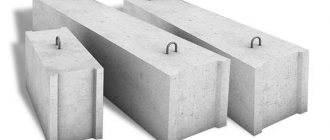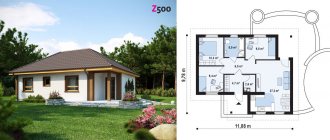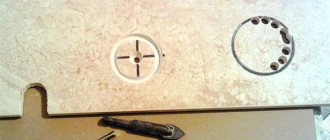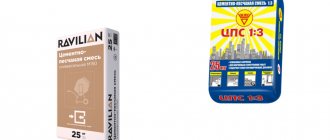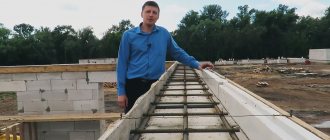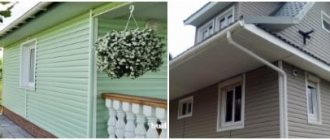Building blocks made of sawdust and cement - manufacturing features
There are cement-sawdust materials - this is a real alternative to aerated concrete and foam concrete, as well as wood, brick and other materials in the construction of low-rise bathhouses and houses.
The material has excellent properties and, at the same time, undoubtedly pleases with its accessibility.
In addition, you can not only buy blocks of sawdust and cement, but also make them yourself at home without purchasing expensive equipment, and if there is a main component - chips or sawdust, then this makes wood-cement building blocks as profitable as possible.
Characteristics of sawdust blocks
Materials based on cement and sawdust are included in the group of lightweight concrete - solutions with a low specific gravity. They use cement mortar as a binding material, and sawdust and chips of various wood species act as filler.
Blocks of wood chips and sawdust
According to their purpose, sawdust blocks can be used for walls and partitions. The former are used for the construction of walls, the latter for the construction of partitions. Products can be solid or hollow, and in the latter the holes are through or blind.
Partition blocks
Sawdust blocks have many unique properties, and the main one is low thermal conductivity. The material is able to retain heat in the house, and also seriously increases the sound absorption of the walls.
Important! The heat retention rate depends on the mass of sawdust blocks. Thermal insulating sawdust concrete is a product with a specific gravity of 0.4-0.8 t/m³. Structural blocks weigh more - 0.8-1.2 t/m³.
Compound
Sawdust blocks consist of the following components:
- Portland cement grade M400 or higher;
- wood chips, wood shavings;
- sand;
- lime
To improve the properties of the material, impregnations against rodents, antiseptics, fire retardants, etc. are also added to the composition. To increase the strength of the blocks and their fire resistance, as well as to reduce moisture absorption, sawdust is soaked in lime milk or liquid glass.
Component Features
Chip blocks are made from waste from lumber production from different types of wood. The best choice is sawdust from coniferous trees, especially spruce, since they contain a lot of resin that protects the raw material from rot.
Softwood sawdust
Deciduous trees that can be used for this purpose are oak, hornbeam, beech, and birch. Blocks with pine chips harden quickly and become suitable for construction 40 days after pouring. Oak and larch contribute to a longer development of strength - up to 100 days.
Proportions
The ratio of components in the material must be optimal, otherwise its density and other technical characteristics will deteriorate.
Sawdust blocks are divided into classes:
- M5-M10 (density 500-650 kg/m³) – for wall insulation, reconstruction of buildings;
- M15-M20 (density 800-950 kg/m³) – for the construction of internal and external walls.
To produce a cubic meter of M5 sawdust concrete, you need 50 kg of sand and cement and 200 kg of lime and sawdust. For grade M10 you need 100 kg of cement, 150 kg of lime, 200 kg of sand and sawdust. Brand M15 requires consumption of 350 kg of sand, 150 kg of cement, 200 kg of sawdust and 100 kg of lime. For a cubic meter of sawdust concrete grade M20 you need 500 kg of sand, 200 kg of cement and sawdust, 50 kg of lime.
Mixing ingredients
First, all components are measured and weighed. Cement and sand are mixed together, then lime and sawdust are added and the mass is mixed well. Water is poured in portions to achieve a solution of the desired consistency.
Advice! It is better to do a test batch first to evaluate the elasticity of the mixture. The lump of solution in your hand should not crumble (there is not enough water in it) or spread (there is too much moisture).
Sawdust size
Typically, sawdust with a size of 5-20 mm is used for the production of blocks, although this indicator does not have a big impact on strength. But the uniformity of sawdust is an important standard, so before mixing the solution, they should be sifted through a sieve with cells of a certain size.
Coarse sawdust
Sawdust is taken on a disk or band sawmill. Waste from calibrating and rounding machines is not suitable due to its heterogeneous structure.
Blocks based on shavings and cement - area of application
The material is used in a variety of fields, but mainly in the construction of low-rise buildings. Most often, sawdust concrete is used to build dachas, garages, internal partitions in private houses, town houses, cellars, cottages, and domestic buildings.
Sawdust concrete is also popular for carrying out work on insulating basements, capital walls of buildings, and creating an insulating layer. Blocks can be useful in the construction of various types of fences. They are rarely used where there are heavy loads - the construction of a foundation, load-bearing walls, floors, etc.
Usually they use the maximum thermal insulation characteristics and implement structural solutions indoors, in creating unloaded structures, etc.
Where there is high humidity, it is advisable to make slabs or blocks with an additional layer of insulation, as they will absorb moisture. With proper protection and consideration of all properties, sawdust concrete made from wood chips is able to retain its geometric shape, as well as mechanical and operational properties, for a long time.
Advantages and disadvantages
The blocks have a number of positive properties that make them indispensable in low-rise construction:
- Excellent thermal insulation properties. The house will be warm in winter and cool in summer. You don’t have to spend a lot of money on additional wall insulation.
- Environmental friendliness. All components are safe, environmentally friendly, and do not emit toxins.
- Reliability. Among other lightweight concretes, sawdust concrete is distinguished by its strength, and therefore is suitable for creating load-bearing structures (some types of blocks can even be used for the construction of 3-story buildings).
- Fire resistance. Sawdust, after mixing with cement, ceases to be flammable. Thanks to the additives, sawdust blocks can withstand fire for 2 hours at a temperature of about +1200 degrees and do not catch fire.
- Vapor permeability. The structure of the blocks is porous, so air can freely leave the room, which contributes to the formation of a favorable microclimate. Excess moisture will evaporate and will not accumulate indoors.
- Soundproofing. Walls made of this material absorb noise, ensuring comfortable living in the building.
- Low cost. For the production of sawdust blocks, recycled materials are used - waste from the woodworking industry, which in some cases can be obtained free of charge or at a minimal price.
- Easy to use. The blocks are easy to cut, saw, and drill without cracks. They are lightweight, so they can be lifted and carried without problems.
- Long service life. If protected from moisture, a house made of such material will last for many years.
This type of building materials also has disadvantages. Their production is quite long, and you will have to wait several months until they dry completely.
Not all types of sawdust are suitable for work, which should also be considered one of the disadvantages of the technology. The blocks have low moisture resistance - they are afraid of water and actively absorb it, so you will have to immediately rack your brains about reliable protection of all surfaces.
Sawdust for ceiling insulation
The issue of ceiling insulation should be approached very carefully, since about 20% of the heat is lost through the ceiling. At the same time, sawdust as ceiling insulation must be mature, dry, and free from fungus and mold. There are several options for making ceiling insulation. For example, you can make a mixture using cement, or you can use clay.
sawdust insulation with added cement
To properly make insulation from sawdust with your own hands with cement, you will need to do the following work:
- The rough ceiling must be covered with glassine or other waterproofing material. In this case, ceiling beams, like all wooden structures in the house, must be treated with fire-retardant emulsions.
- Mix sawdust and cement in a ratio of 10:1. After this, add water so that the mixture is slightly damp (1-1.5 buckets of water). After mixing the mixture, the sawdust appears smeared in the cement.
- The resulting mixture is placed between the beams along the surface of the floors, then compacted. The thickness of the insulation layer laid between the beams is about 25 cm. The special secret of such a heat-insulating layer is good compaction of the mixture.
Types of wood-cement materials
Among the blocks based on wood-based raw materials, one can distinguish wood concrete, fiberboard, sawdust concrete, CSP and xylolite.
Arbolit
This material contains a large volume of wood chips, Portland cement, water and various chemical additives. Also, chaff straw, cotton, flax, and hemp brome are often added to the composition.
Arbolite blocks
Wood concrete can be used for thermal insulation and construction, the latter being characterized by high strength but less pronounced insulating properties. Most often, the material is used as floor slabs, wall panels, and ceilings.
Fibrolite
Fiberboard is produced in the form of slabs. It contains shavings up to 35 cm long and 5-10 cm wide, ground to the state of fibers, which are treated with potassium chloride. Afterwards the filler is mixed with cement mortar.
Cement-fibrolite boards
The mass is pressed under pressure into slabs, treated with heat and dried. Fibrolite is a rough, fireproof material. It has the lowest thermal conductivity of 0.08-0.1 W/m², but is prone to mold damage.
Sawdust concrete
This material consists of sand, concrete, lime or clay and sawdust of different fractions. Its strength is lower than that of wood concrete, as are its heat-insulating properties.
Important! The main advantage of sawdust concrete is its low price.
Cement particle boards (CSP)
The material consists of a wood-shaving mixture, water, cement and a number of mineral components. It is produced by molding, pressing and heat treating the solution.
The finished slabs are non-flammable, frost-resistant, and biologically inert. Most often they are used for finishing facades and for interior work. The disadvantages of DSP are quite heavy weight and low elasticity and fragility.
Xylolite
Contains magnesium binder, wood flour and sawdust, alkali pigments, talc, marble flour. It is prepared under high pressure, so the slabs are very durable, resistant to shock loads, moisture, and frost.
Insulating a bathhouse ceiling with clay
Despite the cheapness of clay, you should not think that it is quite simple: dig up clay and fill the ceiling with it.
In this case, it will crack and have less thermal insulation properties. Therefore, since ancient times, clay has been used in combination with other materials. For example, these include:
- sawdust;
- ground straw;
- tree bark;
- sand;
- expanded clay
The combination with sawdust, straw and sand is considered the most common. The use of expanded clay is advisable when laying clay in layers.
Any of the above additional components will provide increased layer strength and better thermal insulation.
Making blocks yourself
For work you need to prepare raw materials:
- cement M400;
- clean sand;
- lime;
- wood sawdust.
If the sawdust is wet, they are treated in advance with liquid glass or milk of lime, after sifting to remove debris. Raw materials of different fractions are crushed again in a hammer crusher. All components are mixed in a concrete mixer, poured into molds and placed on a vibratory pressing plant.
To dry, the molds are covered with film and kept for 12 days at a temperature of +15 degrees or more. Afterwards, the material is brought to final strength (the period depends on the type of sawdust). Ready-made blocks can be used for a variety of construction and repair work, because they will be reliable, high-quality and durable.
Application of various auxiliary components
The principle of operation of insulation is the same - the wood base, containing small inclusions of air in its structure, is mixed with a binder mass, which, after drying and gaining strength, forms a monolith.
Each composition has its own properties: rising time, viscosity, elasticity, which can be transformed with the help of additional substances. Each composition has its own nuances and its own solutions for specific tasks.
- So, to insulate the floor, sawdust is used instead of mineral wool. To increase their service life and reduce the rotting process, they are knitted with PVA glue with the addition of an antiseptic solution.
- If you need to pour it into a mold, add a small amount of Rotbant or TG to the cement-bonded mixture to speed up the setting. So, if you add a glass of gypsum to a bucket of the mixture, the cement will set within 1-2 hours.
- The same method works with lime compounds.
general information
Wood concrete is not a new element in the building materials market. The very idea of manufacturing was based on the example of building houses from adobe bricks. The first tests of wood concrete were carried out back in the 20s of the last century and were successful.
Wood-concrete material began to be produced on an industrial scale in the 60s , both in the USSR and abroad. In the Soviet Union, it passed all tests and was recognized by GOST. In addition, work was carried out in laboratories to improve properties. Wood concrete has proven its effectiveness in the harsh conditions of Antarctica, where several buildings at the Molodezhnaya station were built from it. To ensure normal temperature, a wall with a thickness of only 300 mm was used. Unfortunately, at that time the building material was not widely used, since all efforts were devoted to the construction of reinforced concrete large-panel houses, and issues of economy and ecology were half forgotten. The production of wood concrete, of course, did not stop completely, and dozens of enterprises operated on the territory of the Union, which were only a drop in the ocean on the scale of a huge country.
Currently, the material is gaining popularity, which leads to the opening of new enterprises for its production.
Types of sawdust
Sawdust is a product of wood processing, and its shape depends on the type of technological operation as a result of which it was formed:
- Small trash. It is formed when cutting wood. The parameters of the dust strongly depend on the characteristics of the saw.
- Chips (3-5 cm in size). It is obtained by drilling and planing.
Depending on the method of wood processing, the fractional composition of sawdust also changes. Fractions usually go on sale in the range of 5-30 mm. Being highly environmentally friendly, sawdust is very inexpensive. In addition, they are lightweight and have excellent sound and heat insulation properties. Sawdust of various species is further used:
- ate;
- pine trees;
- oak;
- ash
Dimensions of arbolite slabs
The distinctive feature of these products from wood concrete blocks is reflected in their name. The concept of “slab” implies that the thickness of a unit of such products is noticeably smaller than its other dimensions - length and width.
For their production, recycled wood chips and a binding component - cement are also used. The production of canvases is carried out by tamping and pressing. Compared to the process of producing slabs from all grades of lightweight concrete, the production of such products from wood concrete takes significantly less time (the duration of vibrocompression is only 20 seconds). In order for the products to gain brand strength, they are left for several days in a room with strictly controlled temperature conditions.
Arbolite slabs are used for the construction of walls, window and door openings, for ordinary, upper and reinforced lintels
Helpful advice! To ensure a long service life of wood concrete slabs, their external and internal finishing must be completed as soon as possible.
Currently, wood concrete slabs are produced in the following sizes (unit of measurement – centimeters):
- wall canvas (these are the largest panels) - 28x118x229, 30/40x118x230;
- narrow blades (products for upper lintels, extensions) - 28×58×229, 30/40×60×230;
- window panels - 28x58x81, 28x118x81 and 30/40x118x80;
- ordinary jumper blocks - 28×178×58;
- reinforced jumper blocks - 28x238x58.
During the production of external panels equipped with fastening reinforcement loops, they are immediately covered with a “rough” facing layer. This layer consists of cement-sand plaster, and its thickness is 150 mm. This technical solution allows the customer to save on external finishing.
Wood concrete slabs can have different sizes and shapes


